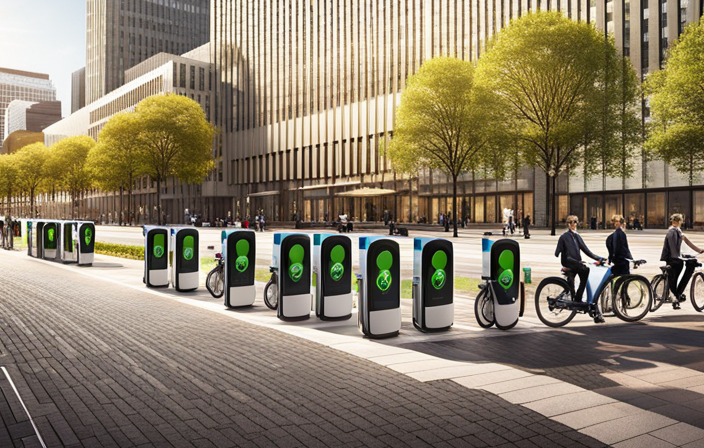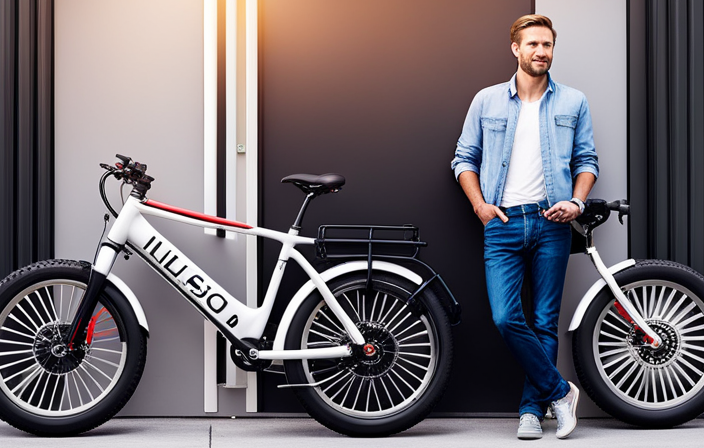Imagine you’re on a journey, cruising down the open road, wind in your hair, powered by the hum of an electric bike. But just like any adventure, your bike’s battery will eventually need to be recharged.
The burning question is, how long does it take for an electric bike to charge? In this article, we’ll dive into the fascinating world of electric bike batteries, explore the factors that affect charging time, and even glimpse into the future of electric bike charging.
Get ready to power up!
Key Takeaways
- Charger compatibility is important for efficient and safe charging.
- Battery capacity determines the charging time.
- Charger power output influences the charging speed.
- Extreme temperatures can affect the charging time.
Understanding Electric Bike Batteries
You can easily understand electric bike batteries by learning how long it takes for them to charge. Charger compatibility is an important factor to consider when charging your electric bike battery. Make sure to use the charger that is specifically designed for your bike’s battery to ensure efficient and safe charging.
Additionally, understanding battery charging cycles is essential for maintaining the longevity of your battery. Most electric bike batteries have a limited number of charging cycles before their performance starts to degrade. It’s crucial to avoid overcharging or undercharging your battery to maximize its lifespan.
Now that we have covered the basics of electric bike batteries, let’s delve into the next section about charging basics: voltage and amps.
Charging Basics: Voltage and Amps
Charging an electric bike depends on the voltage and amps. To ensure an efficient charging process, it is crucial to understand the basics of voltage and amps.
Here are some key points to consider:
-
Voltage: Electric bike batteries usually have a specific voltage requirement for charging. It is important to use a charger that matches the voltage of your battery to avoid any damage.
-
Amps: The charging speed is determined by the amps provided by the charger. Higher amps can charge the battery faster, but it is essential to use a charger that is compatible with your battery’s amp rating.
Using portable chargers can provide convenience when charging your electric bike on the go. These compact chargers allow you to charge your bike’s battery anywhere, optimizing your charging time.
Now, let’s delve into the different types of electric bikes and their unique features.
Different Types of Electric Bikes
There are various types of e-bikes with distinct features. When it comes to electric bike maintenance, it’s important to consider the pros and cons of different models. One popular type is the pedal-assist electric bike, which provides a boost to your pedaling efforts. This type of e-bike is great for longer rides and helps to reduce fatigue. Another type is the throttle-controlled electric bike, which allows you to ride without pedaling at all. This can be convenient for those who have difficulty pedaling or just want a more relaxed ride. Lastly, there are electric mountain bikes, designed for off-road adventures with powerful motors and rugged components.
| Type of E-bike | Pros | Cons |
|---|---|---|
| Pedal-assist | Extended range | Requires pedaling |
| Throttle-controlled | No pedaling required | Limited range |
| Electric mountain bike | Off-road capabilities | Heavier and more expensive |
Understanding the different types of electric bikes can help you make an informed decision when it comes to choosing the right one for your needs. Next, we will explore the factors affecting charging time.
Factors Affecting Charging Time
To reduce the time it takes to charge your e-bike, consider factors such as battery capacity, charger output, and charging infrastructure.
Battery charging speed is a crucial factor that determines how long it will take to charge your electric bike. Higher charging speeds can significantly reduce the time needed for a full charge. However, it’s important to note that the charging speed is also influenced by external factors such as the temperature. Extreme temperatures, both hot and cold, can affect the battery’s ability to charge efficiently.
Cold temperatures, in particular, can slow down the charging process. Therefore, it’s important to ensure that the battery and charger are kept in optimal temperature conditions for faster charging.
With this understanding of battery charging speed and its relationship with temperature, let’s now move on to the next section about battery capacity.
Battery Capacity
One important factor to consider when it comes to charging your e-bike is the capacity of the battery. The battery capacity refers to the amount of energy it can store and is typically measured in watt-hours (Wh).
A higher battery capacity means that it can store more energy and therefore allow for longer rides before needing to be recharged. However, it’s important to note that a larger battery capacity also means a longer charging time. This is because the charging speed is directly related to the battery capacity.
Generally, the higher the battery capacity, the longer it will take to fully charge the e-bike. Therefore, it’s essential to find a balance between battery capacity and charging time.
Considering battery lifespan and charging speed, it is crucial to understand the capabilities of the battery before selecting the appropriate charger power output for efficient charging.
Charger Power Output
Make sure you choose a charger with the appropriate power output for efficient charging. A charger with a higher power output will charge your electric bike faster.
Here are four reasons why you should consider a charger with fast charging benefits:
-
Time-saving: A charger with fast charging capabilities can significantly reduce the time it takes to charge your electric bike, allowing you to get back on the road quickly.
-
Convenience: With a fast charger, you can easily charge your electric bike while taking a short break or grabbing a cup of coffee, ensuring you have a fully charged battery when you’re ready to ride.
-
Smart charger features: Some chargers come with smart features that optimize the charging process, ensuring efficient and safe charging while prolonging the overall battery life.
-
Versatility: Fast chargers often come with different charging modes, allowing you to choose between a quick top-up or a full charge depending on your needs.
Considering the importance of charger power output, it is crucial to understand how it impacts battery health.
Battery Health
Now that we have discussed the importance of charger power output, let’s delve into another crucial aspect of electric bike charging: battery health.
Maintaining the longevity of your battery is essential to ensure optimal performance and a longer lifespan for your electric bike. To achieve this, it is crucial to use optimal charging methods.
One important factor to consider is avoiding overcharging, as it can lead to decreased battery life. It is recommended to unplug the charger once the battery is fully charged.
Additionally, it is beneficial to charge your electric bike battery at moderate temperatures, as extreme hot or cold temperatures can negatively affect its health.
By following these guidelines for battery care and optimal charging, you can maximize the lifespan of your battery and enjoy long-lasting performance.
Moving forward, let’s explore the average charging times for different battery sizes.
Average Charging Times for Different Battery Sizes
To determine the average charging times for different battery sizes, you should consider the capacity of your battery and consult the manufacturer’s guidelines. Charging speed is influenced by the battery’s capacity, which is typically measured in watt-hours (Wh). The higher the watt-hour rating, the longer it will take to charge. Additionally, factors such as the charger’s power output and the charging method used can also affect the charging speed.
It’s important to note that faster charging speeds may have an impact on battery lifespan. Therefore, it’s recommended to follow the manufacturer’s guidelines to ensure optimal charging and to maintain the longevity of your battery.
Moving on to small batteries (250-400Wh), these typically have shorter charging times compared to larger capacity batteries.
Small Batteries (250-400Wh)
Small batteries with a capacity of 250-400Wh generally have shorter charging times compared to larger capacity batteries. The charging time for these smaller batteries can vary depending on several factors such as the charger’s power output and the battery’s charging efficiency.
Typically, it takes around 2-4 hours to fully charge a 250-400Wh battery. However, it’s important to note that frequent fast charging can reduce the overall lifespan of the battery. To maximize battery lifespan, it is recommended to charge it at a slower rate when possible.
Additionally, charging efficiency plays a role in the charging time. Higher charging efficiency means the battery can absorb energy more effectively, resulting in shorter charging times.
Now, let’s move on to the next section about medium batteries (400-600Wh).
Medium Batteries (400-600Wh)
You’ll find that medium batteries with a capacity of 400-600Wh have slightly longer charging times compared to smaller batteries. When it comes to charging these medium batteries, it’s important to consider battery efficiency, as it can affect the overall charging time.
Here are three key factors that can influence the battery charging time:
-
Charging technology: The type of charger you use can significantly impact the charging speed. Opting for a fast charger specifically designed for electric bikes can reduce the charging time.
-
Battery condition: The age and condition of the battery can affect the charging time. Older or damaged batteries may take longer to charge compared to newer ones.
-
Charging habits: Your charging habits can also influence the battery charging time. Charging the battery regularly and not letting it fully discharge can help maintain its efficiency and reduce charging time.
Moving on to large batteries (600-900Wh), their charging time and efficiency will be discussed next.
Large Batteries (600-900Wh)
Moving on to the larger batteries, their charging time and efficiency will be discussed next. When it comes to large batteries, the charging time can vary depending on the specific model and charging method used. Generally, a large battery with a capacity ranging from 600Wh to 900Wh can take around 4 to 6 hours to fully charge. However, it’s important to note that this can vary based on factors such as the charger’s output power and the battery’s state of charge.
To give you a better idea of the charging time for large electric bike batteries, here’s a table summarizing some common models and their estimated charging times using different charging methods:
| Battery Model | Charging Method | Charging Time |
|---|---|---|
| Model A | Standard | 4 hours |
| Model B | Fast | 2.5 hours |
| Model C | Ultra-fast | 1.5 hours |
It’s important to choose the right charging method and follow the manufacturer’s recommendations to ensure optimal battery performance and longevity. With this understanding of battery charging time and methods, we can now explore fast charging options in the next section.
Fast Charging Options
To quickly charge your large battery, consider exploring fast charging options available. Fast charging techniques can significantly reduce the charging time of your electric bike. One of the key aspects of battery charging optimization is the use of high-powered chargers. These chargers are designed to deliver a higher current to the battery, allowing it to charge at a faster rate.
Additionally, some electric bike manufacturers offer fast charging capabilities as a built-in feature. This means that you can charge your large battery in a fraction of the time it would take with a standard charger. However, it’s important to note that fast charging may put additional stress on the battery and could potentially reduce its overall lifespan.
Transitioning into the subsequent section about rapid chargers, let’s explore an even faster charging option.
Rapid Chargers
Moving on to rapid chargers, these innovative charging options are designed to significantly reduce the charging time of electric bikes. Rapid chargers utilize advanced technology to deliver a high charging current, allowing for a faster and more efficient charging process.
With these chargers, you can expect your electric bike to fully charge within a matter of hours, rather than overnight. This is especially beneficial for individuals who rely on their electric bikes for daily transportation and need a quick turnaround time.
Additionally, rapid chargers are paving the way for even more convenient charging methods, such as swapping batteries and wireless charging. These advancements are revolutionizing the way we charge our electric bikes, providing greater flexibility and convenience.
Speaking of swapping batteries, let’s explore this alternative charging method in the next section.
Swapping Batteries
One convenient alternative for recharging your electric bike is by swapping out the batteries. This method allows you to quickly replace your depleted battery with a fully charged one, eliminating the need for waiting around for your battery to charge. Here are three reasons why battery swapping can be a great option for electric bike owners:
-
Convenience: With battery swapping, you can simply exchange your empty battery for a fully charged one at a designated battery swapping station, saving you time and effort.
-
Flexibility: Battery swapping also offers the flexibility of renting batteries. Instead of owning multiple batteries, you can rent them as needed, reducing the cost and hassle of purchasing and maintaining additional batteries.
-
Extended Range: By swapping batteries, you can easily extend the range of your electric bike. This is particularly useful for long rides or when you don’t have access to a charging station.
Now, let’s move on to some tips for faster charging your electric bike.
Tips for Faster Charging
If you want to speed up the charging process, you can try these tips.
There are several faster charging methods that can help optimize battery life.
First, make sure you are using the correct charger for your electric bike. Using a charger with a higher voltage or current rating can significantly reduce charging time.
Additionally, keeping the battery at a moderate temperature during charging can speed up the process. Extreme temperatures can hinder charging efficiency, so it’s best to avoid charging in extremely hot or cold environments.
Finally, avoid frequent charging sessions with small intervals. It’s better to charge the battery fully in one go rather than charging it partially multiple times.
By following these tips, you can maximize the charging speed and optimize your battery life.
Now, let’s move on to discussing optimal charging conditions for electric bikes.
Optimal Charging Conditions
Now that we’ve covered some tips for faster charging, let’s delve into the optimal charging conditions for electric bikes.
It’s crucial to understand that charging speed can vary depending on various factors, such as the battery’s health and the charging method used. To achieve the optimal charging speed, it’s essential to ensure that the battery is in good health. This means avoiding extreme temperatures and preventing the battery from fully discharging before recharging.
By maintaining a healthy battery, you can maximize the efficiency of the charging process and reduce the overall charging time. However, it’s important to note that regular maintenance is also key to keeping your electric bike in top condition.
Let’s explore some essential maintenance steps to keep your bike running smoothly.
Regular Maintenance
To keep your electric bike running smoothly, it’s important to regularly maintain it. Battery maintenance is a crucial aspect of this upkeep.
First, make sure to follow the manufacturer’s instructions for charging and storing the battery. Avoid exposing it to extreme temperatures and keep it dry.
If you notice any issues with the battery, such as a decrease in performance or shorter ride times, troubleshooting common problems can help. Check the battery connections to ensure they are secure and clean. If the battery still doesn’t perform optimally, consider consulting a professional technician.
Taking proper care of your electric bike’s battery will not only prolong its lifespan but also ensure consistent performance.
Transitioning into the subsequent section about ‘battery care’, it’s important to understand the best practices for maintaining your electric bike’s battery.
Battery Care
Taking good care of your e-bike’s battery is essential for its longevity and performance. Proper battery maintenance is crucial in maximizing battery lifespan.
To start, always store your e-bike in a cool and dry place, away from extreme temperatures. Regularly inspect the battery for any signs of damage or wear, such as cracks or leaks. Clean the battery terminals with a soft cloth and ensure they are free from dirt or corrosion. Avoid overcharging the battery and always use the charger specifically designed for your e-bike.
It is also advisable to recharge the battery after each use, even if it has not been fully depleted. By following these battery care practices, you can ensure your e-bike’s battery stays in optimal condition, providing reliable power for your rides.
Now, let’s discuss the different aspects of charging at home vs. charging on the go.
Charging at Home vs. Charging on the Go
When you’re at home, it’s convenient to charge your e-bike. But on the go, finding charging options may be more challenging. Luckily, there are portable charging options available for electric bikes that can make charging on the go easier.
These portable chargers are compact and lightweight, allowing you to carry them with you wherever you ride. However, it’s important to note that the charging speed of these portable options may be slower compared to home charging stations.
While home charging stations provide a faster charging experience, allowing you to quickly top up your e-bike’s battery, portable chargers may take longer to fully charge your bike. So, if you’re in a rush or need a quick charge, finding a home charging station would be more beneficial.
In the next section, we’ll explore the advantages of home charging stations.
Home Charging Stations
Home charging stations provide a convenient and efficient way to recharge your e-bike’s battery. With the increasing popularity of electric bikes, it is essential to have a reliable home charging infrastructure. These charging stations are designed to optimize the charging time and ensure that your bike is always ready to hit the road.
-
Customizable Charging: Home charging stations offer customizable settings to meet your specific charging needs. You can adjust the charging rate and schedule to optimize the battery life and charging time.
-
Easy Installation: Installing a home charging station is a straightforward process. Most manufacturers provide user-friendly instructions, and you can easily find professional installation services if needed.
-
Safety Features: These stations come equipped with safety features such as overcurrent protection and temperature monitoring, ensuring a secure and worry-free charging experience.
Now, let’s transition to the next section about portable chargers, which provide flexibility for charging on the go.
Portable Chargers
Portable chargers, also known as power banks, are a convenient option for recharging your e-bike’s battery while on the go. These compact devices are equipped with a built-in battery that can be charged in advance and then used to charge your e-bike when needed.
Some power banks even come with solar chargers, allowing you to harness the power of the sun to recharge the battery. This is especially useful for outdoor enthusiasts who may not have access to traditional power outlets.
Additionally, portable chargers can help optimize charging time by providing a higher charging current than standard wall chargers. This means that you can charge your e-bike’s battery at a faster rate, reducing the time it takes to get back on the road.
Now, let’s discuss charging etiquette in public places.
Charging Etiquette in Public Places
In public places, it is important to be mindful of charging etiquette for your e-bike. As electric bikes become more popular, it is crucial to manage charging queues effectively to ensure everyone has access to a charging station. Here are some guidelines to follow:
- Be considerate of others and limit your charging time to a reasonable duration.
- If there is a queue, make sure to unplug your e-bike promptly when it’s fully charged.
- Avoid hogging multiple charging stations simultaneously, allowing others to charge their bikes as well.
Following these simple rules will help create a harmonious charging environment for everyone.
Now, let’s move on to the next section about extending battery life without compromising on performance.
Extending Battery Life
One way to maximize battery life is by properly maintaining and caring for your e-bike’s battery. Extending battery life is essential for maximizing charging efficiency. To achieve this, it is important to follow a few key practices.
First, avoid fully depleting the battery before recharging it. Instead, try to keep the battery level between 20% and 80% as much as possible.
Additionally, avoid exposing the battery to extreme temperatures, as this can negatively impact its performance and lifespan. Regularly cleaning the battery terminals and ensuring a tight connection will also help maximize battery life.
Finally, it is important to use the correct charger specifically designed for your e-bike’s battery. By following these practices, you can extend the life of your battery and maximize its charging efficiency.
Proper storage is the next step to consider when caring for your e-bike’s battery.
Proper Storage
To properly store your e-bike’s battery, it is important to follow a few key practices. Battery maintenance plays a crucial role in maximizing its lifespan and performance. One important factor to consider is the temperature effects on the battery. Extreme temperatures, both hot and cold, can negatively impact its longevity. It is recommended to store the battery in a cool, dry place, away from direct sunlight and freezing temperatures. Additionally, it is advisable to periodically charge the battery to around 50% capacity before storing it for an extended period. This helps prevent the battery from fully discharging, which can lead to irreversible damage. By following these guidelines, you can ensure that your e-bike’s battery remains in optimal condition, prolonging its lifespan. Speaking of battery maintenance, another crucial aspect is avoiding overcharging.
Avoiding Overcharging
The key to avoiding overcharging your e-bike’s battery is by following proper charging practices. To maximize the battery lifespan, it is important to charge the battery only when necessary and avoid leaving it plugged in for extended periods.
Additionally, it is recommended to charge the battery at room temperature, as extreme temperatures can negatively impact its performance. When charging while on the move, it is advisable to use a charger specifically designed for that purpose, as it will regulate the charging process and prevent overcharging.
Another important consideration is to avoid charging the battery to 100% capacity, as this can put unnecessary strain on the cells. By adhering to these guidelines, you can ensure that your e-bike’s battery lasts longer and performs optimally.
Speaking of battery optimization, let’s now explore the benefits of using regenerative braking.
Using Regenerative Braking
When you ride your e-bike and apply the brakes, regenerative braking captures and converts the kinetic energy into electrical energy to recharge the battery. This innovative system not only helps to extend the range of your electric bike, but it also contributes to a more efficient charging process.
Regenerative braking efficiency plays a crucial role in determining how much energy can be recovered and subsequently used to charge the battery. The higher the efficiency, the more energy can be converted and stored. This, in turn, reduces the overall charging time required to replenish the battery.
Understanding the impact of regenerative braking on battery charging is essential for optimizing the performance and range of your e-bike. Speaking of charging time, let’s now delve into the fascinating relationship between charging time and range.
Charging Time vs. Range
To optimize the performance and range of your e-bike, it’s important to understand the relationship between charging time and how far you can ride. The charging time of an electric bike is directly affected by its battery capacity. The larger the battery capacity, the longer it will take to charge. Additionally, the charging speed also plays a crucial role in determining the charging time. Fast charging can significantly reduce the time it takes to fully charge the battery, but it may have a negative impact on the battery lifespan. It is important to find a balance between fast charging and preserving the battery’s longevity. Considering these factors, it’s essential to choose a charging method that suits your needs. As we move forward to the next section on charging for long-distance trips, we will explore the best practices to ensure a smooth and efficient ride.
Charging for Long-Distance Trips
For optimal performance during long-distance trips, it’s important to consider the charging strategy.
When embarking on a long journey with an electric bike, it’s crucial to have a fast charging option available. Fast charging options can significantly reduce charging time and get you back on the road quicker. However, it’s important to note that fast charging may not be suitable for all electric bike models, as it can potentially degrade the battery over time.
To ensure the longevity of your battery, it’s essential to adhere to optimal charging conditions, such as charging at moderate temperatures and avoiding overcharging.
Additionally, it’s advisable to plan your charging stops strategically, taking into account the availability of charging stations along your route. By considering these factors, you can ensure a smooth and efficient charging experience for your long-distance electric bike trips.
Planning Charging Stops
It’s crucial to consider the availability of charging stations along your route when planning your charging stops. Planning charging routes and maximizing charging efficiency are key factors in ensuring a smooth long-distance trip with an electric bike. By strategically selecting charging stations along the way, you can minimize downtime and keep your journey on track. To assist in your planning, here is a table that outlines the charging stations at five different locations, along with their distance from each other:
| Location | Charging Station | Distance (miles) |
|---|---|---|
| A | Station A | 50 |
| B | Station B | 75 |
| C | Station C | 40 |
| D | Station D | 60 |
| E | Station E | 45 |
With this information, you can plan your charging stops accordingly, ensuring you have enough power to reach the next station. Considering the importance of charging networks and stations in facilitating long-distance travel, let’s now explore how these networks are expanding and their impact on the overall charging experience.
Charging Networks and Stations
Charging networks and stations are expanding rapidly, improving the overall charging experience for electric bike users. With the increasing demand for electric bikes, the need for accessible and convenient charging stations has become paramount. Fortunately, charging network expansion is keeping pace with this demand, ensuring that riders have easy access to charging facilities wherever they go.
These charging networks are strategically located in various places, such as shopping centers, parking lots, and public spaces, making it convenient for riders to charge their bikes while going about their daily activities. Additionally, these stations are equipped with fast-charging capabilities, allowing users to quickly replenish their bike’s battery and continue their journey.
As we transition to the section about charging safety precautions, it is important to note that while charging networks and stations are expanding, it is still crucial to follow proper safety measures when charging an electric bike.
Charging Safety Precautions
Now that we are aware of the various charging networks and stations available for electric bikes, let’s discuss the importance of charging safety precautions.
When it comes to charging your electric bike, it is crucial to take certain measures to ensure both your safety and the longevity of your battery. Here are three key precautions to keep in mind:
-
Proper ventilation: Make sure the charging area is well-ventilated to prevent any build-up of heat or fumes.
-
Avoid overcharging: Overcharging can lead to battery degradation and reduced lifespan. Always monitor your battery’s charging progress and unplug it once it reaches full capacity.
-
Optimize charging time: Charging your electric bike during off-peak hours can help reduce the strain on the power grid and ensure faster charging times.
By following these safety precautions, you can ensure a smooth and efficient charging experience for your electric bike.
Speaking of safety, let’s now explore the next section on avoiding overheating.
Avoiding Overheating
To avoid overheating, make sure you keep an eye on the temperature of your battery while it’s plugged in. High temperatures can lead to battery degradation and reduce overall lifespan. Optimizing the charging temperature is crucial for maintaining the health of your electric bike’s battery.
Most electric bikes have a built-in thermal management system that prevents overheating by regulating the temperature during charging. It’s important to charge your electric bike in a well-ventilated area to dissipate heat effectively. Additionally, avoid exposing the battery to extreme temperature conditions, such as direct sunlight or freezing temperatures.
By preventing battery degradation and optimizing the charging temperature, you can ensure long-term performance and reliability of your electric bike.
Moving on to the next section, let’s discuss the importance of using certified chargers.
Using Certified Chargers
Using certified chargers is essential for maintaining the health and performance of your electric bike’s battery. When it comes to charging your electric bike, using certified chargers ensures that you are providing the right amount of power and voltage to your battery, minimizing the risk of overcharging or damaging the battery cells. Certified chargers are specifically designed and tested to meet the manufacturer’s specifications, ensuring compatibility and optimal charging performance.
Using uncertified chargers or alternative charging methods may seem like a cost-saving option, but they can potentially lead to battery damage, reduced battery life, or even safety hazards. Certified chargers provide several benefits, including faster and more efficient charging, better battery longevity, and peace of mind knowing that you are using a reliable and safe charging solution.
In the next section about proper cable management, we will discuss the importance of organizing and securing your charging cables to prevent any potential accidents or damages.
Proper Cable Management
Proper cable management is crucial for ensuring the safety and efficiency of your electric bike’s charging process. To achieve optimal cable organization, it is important to employ effective cable management techniques. Here are five key practices to consider:
- Use cable clips or ties to secure the charging cable to a wall or bike stand, preventing tripping hazards and potential damage.
- Avoid excessive bending or twisting of the cable, as this can lead to internal wire damage and decreased charging performance.
- Keep the charging cable away from heat sources to prevent potential melting or fire hazards.
- Store the cable in a clean and dry location when not in use, protecting it from dirt, dust, and moisture.
- Regularly inspect the cable for any signs of wear or damage, such as fraying or exposed wires, and promptly replace if necessary.
By implementing these cable management techniques, you can ensure a safe and efficient charging experience for your electric bike.
Looking ahead to the future of electric bike charging, advancements in wireless charging technology may revolutionize the way we recharge our bikes without the need for cables.
The Future of Electric Bike Charging
Advancements in wireless charging technology may soon revolutionize how we recharge our e-bikes.
Imagine a future where we no longer need to plug in our bikes to charge them. Instead, we can simply park them on a charging pad and let the technology do its magic.
Not only does this eliminate the hassle of cables and connectors, but it also opens up new possibilities for battery swapping and solar charging.
With battery swapping, we can quickly exchange depleted batteries for fully charged ones, allowing us to keep riding without any downtime.
Solar charging, on the other hand, utilizes the power of the sun to charge our e-bike batteries, making them even more environmentally friendly.
As we explore advancements in battery technology, we can expect these developments to further enhance the charging capabilities of electric bikes.
Advancements in Battery Technology
You can expect advancements in battery technology to greatly improve the charging capabilities of your e-bike. These advancements in charging technology will have a significant impact on the performance of electric bikes. Here are five exciting advancements that are currently being made in battery technology:
- Faster charging times: With new battery technology, you can expect your e-bike to charge much faster than before.
- Increased energy density: Battery technology is becoming more efficient, allowing for longer rides and increased range.
- Improved lifespan: The lifespan of e-bike batteries is being extended, reducing the need for frequent replacements.
- Enhanced safety features: New battery technology is incorporating advanced safety features to protect against overheating and other potential hazards.
- Smaller and lighter batteries: Advancements in battery technology are making e-bike batteries smaller and lighter, improving overall bike weight and handling.
These advancements in battery technology are just the beginning of the exciting innovations that will continue to improve the charging capabilities and performance of electric bikes.
In the next section, we will explore the fascinating world of wireless charging.
Wireless Charging
Wireless charging technology is revolutionizing the way batteries are powered. It offers a convenient and efficient way to charge electric bike batteries without the hassle of plugging in cables. However, it is important to consider the efficiency of wireless charging. While it may seem like a futuristic solution, it is not as efficient as traditional wired charging. Wireless charging can be slower and less energy-efficient due to energy loss during transmission.
To better understand the pros and cons of wireless charging, let’s take a look at the following table:
| Pros | Cons |
|---|---|
| Convenience | Slower charging speed |
| No cables or connectors | Energy loss during charging |
| Aesthetically pleasing | More expensive technology |
Despite the drawbacks, wireless charging offers a convenient solution for those who prioritize ease of use and aesthetics. However, it is important to keep in mind that wired charging remains the more efficient option. Moving on to the next section about common questions regarding electric bike charging, let’s address some of the concerns users might have.
FAQs: Common Questions about Electric Bike Charging
Now let’s address some common questions about charging your electric bike.
-
How often should I charge my electric bike battery?
The frequency of charging your electric bike battery depends on your usage and battery capacity. It’s generally recommended to charge your battery after each ride or when it reaches 20-30% capacity. Regular charging helps maintain optimal battery health and prolong its lifespan. -
Is it okay to leave my electric bike battery charging overnight?
While it’s generally safe to leave your electric bike battery charging overnight, it’s not recommended for long-term battery maintenance. Overcharging may reduce the battery’s overall lifespan and charging efficiency. It’s best to monitor the charging process and unplug the charger once the battery is fully charged. -
How can I maximize my electric bike’s charging efficiency?
To maximize your electric bike’s charging efficiency, it’s important to use the charger provided by the manufacturer. Avoid using third-party chargers as they may not provide the appropriate voltage and current for your battery. Additionally, keep your battery at room temperature during charging to optimize its performance. Regularly inspect and clean the charging port and connectors to ensure a secure connection and efficient charging process.
Frequently Asked Questions
Can I charge my electric bike battery with a regular power outlet?
Yes, you can charge your electric bike battery with a regular power outlet. There are different charging options available, but the charging time will depend on the battery capacity and the charging rate of your specific electric bike model.
How long does it take to fully charge an electric bike battery?
To fully charge an electric bike battery, the charging time can vary depending on factors such as battery capacity, charger output, and charging method. It’s important to consider these factors when comparing charging times between different electric bikes.
Can I use a fast charger to charge my electric bike battery?
Using a fast charger for my electric bike battery comes with pros and cons. It charges quicker, but can decrease battery lifespan. However, considering the convenience and time saved, I find it worth it.
Is it safe to leave my electric bike battery charging overnight?
Leaving an electric bike battery charging overnight can be potentially dangerous, as it may overcharge and cause damage. It can also shorten the overall lifespan of the battery. It is important to monitor the charging process and avoid excessive charging.
Can I charge my electric bike battery while riding the bike?
Charging an electric bike battery while riding is not possible. However, there are alternative charging methods available, such as solar chargers or portable chargers, which can be used when you’re not actively riding the bike.
Conclusion
In conclusion, the charging time of an electric bike varies depending on several factors. The battery capacity plays a crucial role in determining how long it takes to charge.
Advancements in battery technology are paving the way for faster and more efficient charging. Additionally, the possibility of wireless charging is an exciting development that may revolutionize the charging process.
Overall, understanding these factors and staying up-to-date with the latest advancements will ensure a smooth and efficient charging experience for electric bike owners.
















